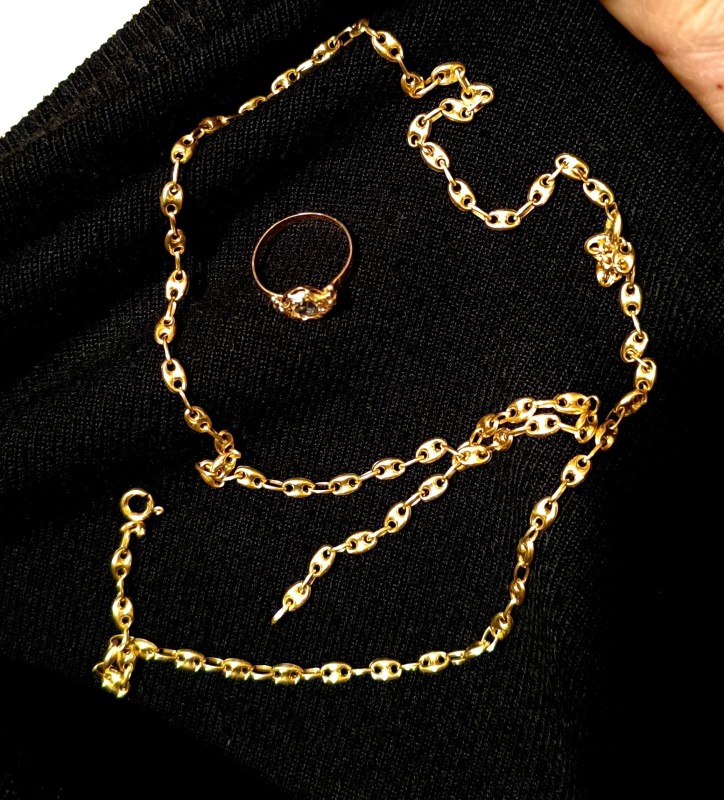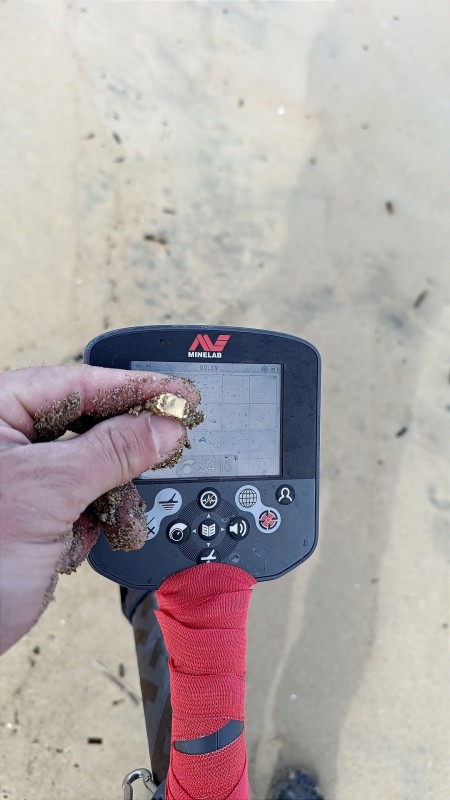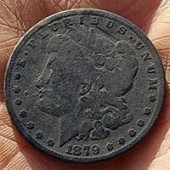Search the Community
Showing results for tags 'minelab ctx 3030'.
-
I took up a ritual as a pure pastime, devoting a few hours to the shoreline. Some time ago I found with great wonder, a small ring in a really forgotten stretch of a beach, where I could barely find iron and a few coins. This morning, it being stormy and so for the rest of the week, I returned a little further than the spot where I was successful. The only promising area with obvious erosion was about 10 square meters. A very strong concentration of clay and black sand was making Ctx sick, so I immediately opened the pattern and changed separation, given the incredible masking I could hear. What happened next, in a dozen coins, is nothing short of a miracle for me. For the first time I found myself looking for a pendant that might belong to the necklace instead of the other way around, and the little ring had opened a sliver of hope amidst very obvious signals, but mixed with really too much iron. I think the necklace gave a minimal signal because of the knot along the links by the way. Nothing else to record for today, but what a day guys!
- 13 replies
-
- 26
-

-

-
- minelab ctx 3030
- jewelry found
-
(and 1 more)
Tagged with:
-
I recently had some doubts about the effectiveness of my sessions and made a radical change in instrumentation. Although I had been adopting the Deus 2 on the bottom for a year continuously now, I first overdid it by dusting the immortal Excalibur and later dusting the Ctx3030... Last week the numbers suddenly spiked and I reluctantly decided to sell the Deus 2. As I write, the new owner of the remote is getting ready to go out for the first time to the beach with my former detector. What happened this morning, however, marks a historic date for me. I am a diver, I practice the shoreline very little, and in my area, given the minimal tidal variation, practically after the first autumn storms the equipment is all in the water... Well, after years, I pulled up a ring in one of the worst spots where nothing but aluminum, iron and rarely any coins turn up. I hate to repeat it, but the time saved by avoiding digging out any possible sign made all the difference. Little does the bit of gold matter; getting to dig it up matters to me. I have no words 🏴☠️
- 6 replies
-
- 17
-

-
- minelab ctx 3030
- jewelry detecting
-
(and 1 more)
Tagged with:
-
Hello group, I wanted to bring up a topic. When and how is it best to use each mode to detect with our ctx? I mean the configurable modes: Low trash High trash Ferrous-coin Ground-coin The name itself indicates the first two for a lot of garbage or little garbage. but the next two? Which ones do you use on the beach or in the countryside? I usually detect it on the beach and depending on the trash I use the first two. Do you think that the remaining two would give good results on the beach? I read you greetings and thank you
-
Does anyone know for sure how much the CTX is going up in price (in the U.S.) as of 1/1/'24?
-
Forgive me if I've brought this up before. So I have a Nox 800 and a Manticore. I really like both of those detectors although other than side by side testing I don't use my 800 anymore. It's just basically a backup these days. I even have a backup for my backup a Nokta Legend. People love the Etrac and CTX for their I.D., depth, and silver finding abilities. Both are still formidable detectors. I do not understand why Minelab has not taken the CTX and put it in a Nox/Manticore form factor. I never owned a CTX, but did own an Etrac. If the Etrac had been as light as my 800 I probably would have kept it. It seems like a no brainer for Minelab to rework the CTX FBS II into a lighter machine. Other than it's weight doesn't the CTX still have a lot going for it? I'd also bet everyone that still swings a CTX would probably buy the lighter version. A 5+ pound machine these days is ridiculous.
-
CTX 3030 on gold nuggets Hi guys I have had the CTX since it was released. However I did not purchase it for the same reasons as most others bought it for, I bought it primarily to look for larger gold in areas that have a high trash density where non discriminating detectors like the GPX will drive you nuts digging junk. It has the best discrimination and target separation of any detector I have used this far, particularly if the trash is iron. That is why I use it for this job if the trash density is low I just swap back to a gold detector and would never waist my time using it in low trash areas for gold nuggets. To give you an idea of what I am talking about with trash density’s and to establish an understanding I will break them into 4 groups. 1- Very low trash= up to 10 targets in a 5mx5m area. This area I would use a gold detector like the GPX in. 2- Low trash 10 to 25 targets in a 5mx5m area. This area I would still use the gold detector in if it is worthwhile. But if the gold density is low I will start to use the discriminating detector. 3- Med trash= 25 to 50 targets in a 5mx5m area. I am definitely reaching for the discriminating detector now unless there is a high gold density. 4- High trash 50+ targets in a 5mx5m area. Discriminating detector only! any other is a waist of time. Ok now that I have established a base line of trash density’s we can get to the nitty gritty, I will go through the settings that have an effect on gold field performance one by one and explain how I use them, or play them against each other to squeeze the best performance out of the CTX that I can for my given situation. Target trace; I turned it on and would never turn it off as it is very useful in helping to identify a target or multiple targets under the coil and I am yet to find a reason to turn it back off. Why this key feature was not on by default is anyone’s guess. Target trace pinpoint; I turned this on and never turned it off ether, as it greatly assists in pinpointing particularly if there are multiple targets under the coil, by using this feature you can pinpoint only the desired target most times. Threshold Pitch; I run it at 13 but everybody is different all you are after is a threshold pitch that is comfortable for you to listen to all day. Threshold level; set up threshold so that it is soft but clearly audible, the manual covers this in detail. Volume Gain; now this is a important one, I mostly just have it at max=30 but if you are getting spurious noises like those faint blipping noises that you can sometimes get in mineralized ground you can wind this back to cancel them out with less loss of depth than turning back the sensitivity, however it has its limitations in this regard. It is basically an audio amplifier that amplifies the target signal. Sensitivity; Obviously you want to keep this as high as possible, but in the gold fields the ground usually contains various minerals and because the CTX is a multiple frequency detector ‘Auto’ sensitivity is more effective in these conditions, because the processor individually adjusts each of them to their optimum setting. Where as in manual you can only adjust them all to the same setting which means that if one is effected by mineralization or emi and becomes noisy, you have to turn them all down to the level where the noise stops in that frequency and you are effectively choking the rest to quieten the detector. So this is why Auto is the best option on the CTX in gold field areas. I can usually run Auto +3 but I turn it down if I am getting a lot of spurious ground noise and I can’t use any of my other tricks to get rid of the noise. Response; My favored response is ‘Long’ but I also like ‘Normal’ as well. It depends on my anticipated target size and trash density as to which one I’ll use. In a medium to high trash area I prefer Long particularly if the gold size is 3g+ like in tailings oversize piles. I like normal for smaller gold and lower trash density. Recovery Fast; I nearly always have this on as it aids in target separation. And superior target separation is one of my main reasons for using the CTX Recovery Deep; I have this on if the trash density is low or medium particularly when using the smaller coils. Recovery deep improves the ID on deep targets and can improve the signal on deep targets marginally but it can cause spurious noise in some mineralized ground. So if it’s on and you are getting spurious noise recovery deep could be the cause so try turning it off before dropping the volume gain or sensitivity. Target Separation; The 2 best target separation modes for gold nuggets are ‘High Trash’ and ‘Ground Coin’, I use High Trash the most as most areas I target most with the CTX are med to high trash areas and High Trash is good at handling mineralization and still gives you very good target separation. In a area with low trash density that is mineralized I use Ground Coin but it dose not perform well in high a trash density as you will get some blending of targets. In a low to very low mineralization area ‘Ferrous Coin’ performs very good no matter the trash density, but is no good in mineralized areas as you will get blending of the ground and target, which makes the target ID go crazy and blending is a problem. Gold Hunting Discrimination and Audio Patterns. Below I have posted a few example modes that have a good base discrimination pattern and audio pattern to suit the situation that I use them in. 100’s of hours of work went into building each of them. When building your own pattern I recommend that you do what I did which is scan as many nuggets as you can get your hands on of various sizes. When I did this I scanned just over 1000 nuggets ranging from .2g to 32oz and I put the ones that show on the edge of my pattern aside and took them to a few locations and buried them in different mineralization to test and modify my mode’s, then I got my bucket of junk and scanned 1000’s of pieces of junk commonly found in the gold fields. Then I modified my modes again to cancel out most of the junk whilst still keeping most of the nugget area open. They are not perfect by any means but they have been pretty useful for me as a base but if I keep getting one type of junk in a specific area I will modify the discrimination to deal with it and save it as a new mode in my file. You might also notice that in all of my gold specific discrimination patterns that I have the top two lines rejected, this is because in mineralized ground the ground will give you a blipping signal always in these top two lines and rather than sacrificing performance by turning the sensitivity or audio settings down I dealt with this by blanking it out, buy doing it how I did I lost no depth due to having to back off the settings and no good target ever ID’s only in these lines. The audio patterns that are part of the mode also have a few tweaks that I have done for gold nugget specific reasons. If you look at the Audio profile in the exchange software you will notice that I have set the low Ferrous tone line very low down at the 32 ferrous line, I did this because I found that when using the discrimination pattern if the tone was set higher up at say 17 for example I would get some audio blanking or mixing on some good targets in very trashy areas. This is the main reason that most of my Gold nugget modes have ether a ‘2 Ferrous Tone’ or ‘Combined’ ‘Tone ID Profile’. But when set low at 32 ferrous line the separation was very good in a cluttered area. It is not that noticeable on larger 3g+ nuggets but on the smaller ones even on the smaller coils (6in and coiltek elliptical) if I had the ferrous audio line higher it would not separate the nugget from the trash as efficiently. That is why I mostly prefer the discrimination pattern over the open screen also. http://www.detectorprospector.com/forum/files/file/4-gold-hound-ctx-gold-modes/ Coils My preferred coil for the CTX is the standard 11in coil because I mostly chase the bigger gold in the tailings oversize piles and old diggers camps. But in areas with predominantly smaller gold I put on the coiltek 11x5. I also did away with the skid plate on the ML 11in coil as it wears out in a matter of hours in gold field situations and I silicon-ed a piece of 3mm lexan plastic in its place. And after 2 years of heavy use it is still in good condition!
-
I'm wondering if the big coil has any real world depth advantage over the 11" for deep coin hunting. I just bought a new CTX that came with the big coil and need to know if it's worth keeping and using for getting any extra depth on coin sized target. My soil is very mild so mineralization issues shouldn't be a problem using 13x17. If it's only advantage is coverage, then I'll probably sell it. Thanks in advance.
-
Yay! Minelab finally updated Xchange 2 so it still works with Google maps, some time ago Xchange being so old was no longer compatible with Google maps and they've finally fixed the problem somewhat properly using a patch that runs in the background. You can download the fix to your Xchange 2 (Windows) here https://www.minelab.com/__files/f/507670/XChange2-1.8.7-1.3.5-Hotfix.exe XChange2 - Hotfix for mapping and pin fixes. (Released July 2023) External interfaces used by XChange2 change over time which can affect the way that XChange2 needs to work. Installing the XChange2 Hotfix file after installing the XChange2 1.8.7-1.3.5 program will help XChange2 maintain it's compatibility with Google maps so that detectorists can continue to use the program as intended. Step 1 - Download and install XChange2 1.8.7-1.3.5 Step 2 - Download and run XChange2-1.8.7-1.3.5-Hotfix.exe (This will take a few minutes.) Step 3 - Restart your computer then run XChange2 as normal. (the Hotfix will run in the background.) --- Note for Minelab, maintain its compatibility. 🙂
- 6 replies
-
- 2
-

-
- minelab gpz 7000
- minelab ctx 3030
-
(and 1 more)
Tagged with:
-
Minelab CTX3030 beach hunting presets by Gary Drayton (factory beach mode preset) Rocky Areas on the Beach and water Pattern 1 Pattern 2 in cross reference with Pattern 1 for checking Target Trace Target Separation Low Trash or High Trash Recovery Deep OFF Recovery Fast ON Seawater ON on lower parts of beach Sensitivity manual In water try dig only low and high tones Rough Surf Hunting Recover Deep OFF Seawater ON Target Separation – Low Trash Volume Gain – few numbers down to cut false signals Sensitivity Auto Deep Water Hunting Pattern 2 Seawater ON Sensitivity Manual to MAX or AUTO +3 (rolling surf) until threshold becomes unstable Volume Gain 24 for flat surf Volume MAX Recovery Deep ON Recovery Fast OFF Target Separation – Low Trash Shallow Water Seawater ON Sensitivity AUTO or manual to first unstable at fully submerged section try to wait few minutes to stabilize temperatures Volume Gain 22-24 Recovery Deep OFF Recovery Fast OFF Target Separation – High Trash Eroded Beaches Pattern 1 Sensitivity Manual try to crank up to maximum Target Separation – High Trash Volume Gain 24 Recovery Deep OFF Wet Sanding Hard packed sand Seawater ON Pattern 2 or Relic Search Mode Sensitivity Manual Recovery Fast OFF Recovery Deep ON Target Separation – choose to conditions Soft sand Pattern 2 Sensitivity Manual or Auto +3 Recovery Fast ON or OFF (dependent on the amount of targets) Recovery Deep ON (for soft sand on lower beach) Recovery Deep ON Target Separation – choose to conditions Dry Sanding Pattern 1 Target Separation – High Trash Recovery Fast ON Recovery Deep OFF Shipwreck Beaches Pattern 2 Sensitivity Manual Recovery Deep ON Target Separation – Low Trash or High Trash – conditions Volume Gain 24 4 CO Tones Target Trace ON Tourist Beaches Pattern 1 Sensitivity Manual or Auto Recovery Deep OFF Recovery Fast ON Target Separation – High Trash 4 CO Tones Target Trace
-
Today I´m preparing for tomorrow dive in my usual and devastated gulf spot... After the shaft accident with the new toy the last week, Ive been captured by a stupid doubt... What about the use of a single frequency on the Ctx ? I know, this thing isn´t possible due to the kind of machine with an FBS range continuously at work, but somewhere I found a text related to the noise cancel channel and the different frequency in use... So In these years, I think the succesful use of a frequency among 15 and 20 Khz in salty environment it is not a secret anymore but what about this particular machine stated at 1 to 100Khz? So tomorrow morning I want to try all of the 11 channels and manual settings for sensitivity and noise cancel, adding the ground/coin separation that for sure is the more stable giving a less jumpy target ID... Feel free to laugh at this post but I feel like a child again...
- 16 replies
-
- 4
-

-
- minelab ctx 3030
- underwater detectors
-
(and 1 more)
Tagged with:
-
Check your cables. This is the Cable that goes to the control panel not the coil cable. Recently I noticed that the screen back light would not turn on...now the screen itself is dimming out with shadows...This is a 2017 model. The interesting thing was that I had a an screen giving me problems on my first CTX but I never checked the cable I just sent it in to be fixed. wondering if this is a common problem. strick
-
With the soon-to-be-released Manticore (maybe) about ready to take over this site's discussions, I'm curious to get some educated opinions about its forerunners in graphics capability. I'm pretty sure I know what's been revealed so far about that detector from the limited number of (emphasize) quality videos done in September in Europe. But many here have experience with current and former models with related readouts. 1) What detector(s) with graphics readout have you owned? Please give at least a rough description of what the graphics showed. 2) Please describe how this detector(s) improved your detecting experience. Also helpful if you'll describe your type of detecting (coins, relics, jewelry) and type of sites (beach, strength of mineralization). Did the detector(s) actually give you useful capabilities that other detectors that you've used -- without graphics -- couldn't? (I mean out-performed in some way.) 3) What were the shortcomings of this detector(s)? 4) Is this detector(s) still in use by you, and if so, where does it rank/rate in your arsenal? Anything else you can add that would be helpful is welcome. Although I don't want to discourage valuable discussion, I'd rather not read second hand info (my friend had one..., I read on a forum that...). Thanks.
-
-
This is to you guys with CTX experience. I am giving up hunting Civil War relics for a while and concentrating on finding rings in tot-lots, volleyball courts and old baseball fields. Of course I will take any silver I find, but I am really after rings. Any hints, suggestions on determining rings from metallic trash? Skippy SH13 Friendly Metal Detecting forum has good luck finding rings in landlocked areas. He uses AT Pro and AT max now. He states: When you target gold, you consider each piece of trash you come across and rule out anything that is likely NOT to be Gold. Of course I know rings can ring up from 01 to 36 on the CO scale which makes hunting rings a challenge. Do you know of any tricks like determining silver coin from clad coin switching between FC & high trash and 50 tones? Always looking to the experienced CTX users for help. John
-
Hello I have a minelab ctx3030 can someone please tell me what do I need to change in the settings so i can use the metal detector at maximum manual sensitivity because now it’s hitting all the time targets…. And another friend of mine did some setting and he doesn’t have this problem but he doesn’t know what he changed. If I switch back to Auto sensitivity it doesn’t hit nothing only if he feels a real target
-
Hi, A distant acquaintance offers me a CTX 3030 for the price of a Nox 800. Having a Nox 800, I wanted to know if the CTX3030 might be of interest to me. I only practice in lands, woods, fields etc (never beach), I don't need its GPS function. In France, it is complicated to get feedback from this detector outside the beach. In short, is the CTX3030 better than the Nox800? Aside from its lower recovery speed. Should we wait for future releases of Minelab devices in 2022? Thanks.
-
So my 17" CTX 3030 has already formed a crack in it's coil ear, I don't trust it now so I want to 3D Print a strengthener and glue it on. Does anyone have 3D print templates for the CTX coils, especially the 17" but I'd like them for all of the coil sizes if possible so I can do it to all of my coils. I'm finding sellers of the 3D printed ears mostly in the US and UK so shipping is an issue, easier to just make one here if I could get the template. I used a bit of uPVC solvent primer and then uPVC glue and that seemed to dissolve the plastic at the crack and melt it back together, so that's looking pretty good, I just want to glue the 3D printed strengthener on there now, the coil ears are pitifully thin for such a big coil. Thanks
-
Sorry if this thread has been discussed before. (I did have a look around the forum but couldn't find a comparison between machines) I've decided to have ago at coin/relic hunting. When talking to a dealer that regularly detects I got the impression that the 3030 was still an all-round better machine than the equinox. The purchase price is not part of the decision, more so id like to purchase something I'm going to be happy to keep as i learn more about relic hunting. My wife and I regularly head off on short trips and would like to go to other areas other than the gold fields all the time. I'm thinking the ability to detect beaches/parks and old historic sites would be nice. Although I've often thought id love to have something that could go over old-timers gold camps and discriminate out the iron better than the gpx4500. So the question is what would most people get? The 3030 or the Equinox 800. Or would there be some other machine that would be worthy of consideration?
-
Hi, Does anyone have the "Tadpole 4" and « Ghost 4" programs for the CTX3030? I searched the net without success. Thanks. David
-
Ever wondered why pennies ring up so differently? Well you probably knew, but here are some more detailed results tested on the CTX3030 in the Ferrous-coin mode with the pennies on a patch of ground cleared of any other metal. You can easily see from the data that the TID values change when the composition or weight changes.
-
Curse of Oak Island watchers will notice that after 9 seasons the Minelab CTX-3030 is still the machine of choice for the crew, particularly Gary Drayton. I know there has to be more people like me, bitten by the bug, watching and waiting to see if the Equinox would make an appearance. To date, it has not. Other than the occasional GPX-5000 clip, and some imaging hardware, CTX-3030 remains the primary detecting platform on the show, and often enough time is taken to point out the make and model being used. So one has to wonder, if not for The Curse Of Oak Island, where would the CTX-3030 be in light of the Equinox. I don’t claim to know how many CTX-3030s have been sold on the basis of the show, but I do know it’s not even close to none. It’s a significant amount, particularly among those wanting “the best.” People assume, rightly or wrongly, that the now elevated, popular show and a “metal detecting expert” like Gary Drayton would not be using anything less than the best. You don’t have to go far into various threads to realize a lot of people have sat up to take note of what machine is being used, and have expressed a desire to own it. In various threads regarding current owners the show comes up quite often as a basis motivating their purchase. The continuing high price tag of the unit, at $2,500, seems to confirm their impressions. Is it reality though? Can the CTX-3030 still be considered the best or one of the best? Clearly, metal detecting manufacturers have all but ignored it, setting their sights instead on the Equinox. If you were to take away the color display of the CTX-3030, and just look on paper, and at field results, you begin to wonder. The CTX makes the claim that it utilizes a full band of 28 multiple frequencies from 1.5khz to 100khz. Field results and independent spectral analysis does not support that claim. Rather, it seems to utilize one 3.125khz fundamental frequency and one 25khz harmonic frequency in each and every mode, leading to a bias toward deep silver, and user feedback that the unit is weak on fine gold; results that are entirely what you’d expect in light of the spectral analysis. Enter the Equinox. The Equinox was an obvious redress of some of the most common feedback about the CTX-3030 and other BBS/FBS multifrequency units, mostly that they were slow to recover and overlooked fine gold. It may have also been a response to those who had chosen the V3i over FBS platforms claiming they could get the best of both single frequency and multifrequency worlds. The Equinox now offered a range of single frequencies, which the CTX doesn’t, and mode/task tailored frequency blends, whereas CTX frequency weighting never varied from mode to mode, instead depending upon other settings to vary performance. The Equinox retained the ability to seek out deep silver, while gaining the sensitivity to seek out gold fine enough to make it a competent prospecting unit. With a new approach to recovery speed the Equinox could now hunt among commingled sites in a way CTX couldn’t according to many users. While there’s no shortage of those insisting the CTX-3030 is still the best (often citing the high tag rather than its ability), there’s also no shortage of those claiming to have dumped the platform in favor of their Equinox. There’s also those in the middle, claiming a marriage of sorts between the two platforms would be detecting nirvana. What say you? Is the CTX-3030 still one of the very best? Is it still worth $2,500 in light of the Equinox? Did the Curse of Oak Island ever shape your or anyone you knows initial view of the CTX-3030?









.thumb.jpeg.7fe81ce2e2afd0eb0ac336110923827d.jpeg)








